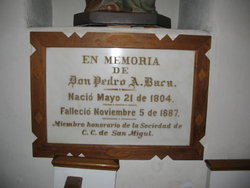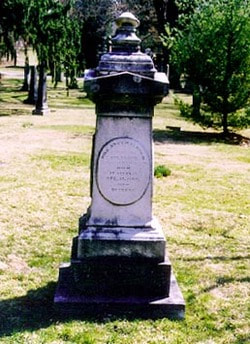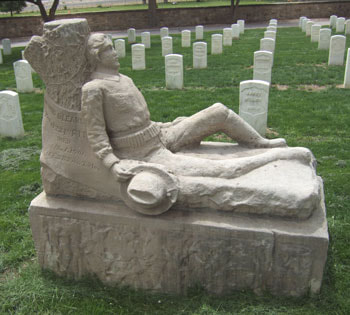
Some of the people in Where Duty Calls and and The Worst Enemy, my two historical novels set in the Civil War in New Mexico, are fictitious, and therefore have no grave markers. They were never born, and they will never die as long as readers keep them alive.
But other characters in both stories were real people, with lives that began long before I wrote about them - lives that were filled with events that I didn't include in my novels. After the war was over, many of them went on to do interesting things -- some good, some bad. Some continued to live in the public eye, while others dropped into obscure, private lives.
William Marshall, who has a small role in my novel The Worst Enemy, was the last man killed on the first day of the battle that raged on March 20 in Apache Canyon. He had survived the day's fighting and was collecting discarded Confederate weapons and disabling them when one went of, mortally wounding him. Exactly what weapon and how he died is up for debate. Click here if you want to read more about why. Marshall's grave marker is in the cemetery at Fort Leavenworth, Kansas.
But other characters in both stories were real people, with lives that began long before I wrote about them - lives that were filled with events that I didn't include in my novels. After the war was over, many of them went on to do interesting things -- some good, some bad. Some continued to live in the public eye, while others dropped into obscure, private lives.
William Marshall, who has a small role in my novel The Worst Enemy, was the last man killed on the first day of the battle that raged on March 20 in Apache Canyon. He had survived the day's fighting and was collecting discarded Confederate weapons and disabling them when one went of, mortally wounding him. Exactly what weapon and how he died is up for debate. Click here if you want to read more about why. Marshall's grave marker is in the cemetery at Fort Leavenworth, Kansas.
Frederick Wade and John Norvell, who both served with the fictional Jemmy Martin, survived the war and went on to live long and full lives. Both were newspaper editors and writers, and their memories, published in newspaper accounts, helped give life to my novels. They appear in all three of the books in this series: Where Duty Calls, The Worst Enemy (scheduled to be published August 2023), and The Famished Country (scheduled to be published spring 2024).

Pedro Baca shows up in Where Duty Calls and will also appear in the final book of the trilogy. The real Pedro Baca was married to a different woman than my fictionalize character, and he had many more children. He was an outstanding member of the Socorro community and is buried within the church there.

After resigning his commission with the Colorado Volunteers after the Battle of Valverde, John P. Slough was first given command of a brigade in the Shenandoah Valley, then was appointed brigadier general of volunteers and finally became the military governor of Alexandria, Virginia. When the war ended, President Andrew Johnson, appointed Slough to serve as chief justice of the New Mexico Territorial Court. Slough returned to New Mexico and helped fund the Civil War monument in Santa Fe that was recently torn down. He also was instrumental in the creation of the Veteran's Cemetery in Santa Fe.
Slough had a fiery temper and a keen sense of justice that often put him at odds with the locals. His decisions to accept Pueblo Indians as U. S. citizens who could testify in his court and his attacks on the peonage system led for some to call for his removal. Slough died when he got into a disagreement with a member of the Territorial Legislative Council, who shot him in a pool hall argument. He is buried in Cincinnati, Ohio.
Slough had a fiery temper and a keen sense of justice that often put him at odds with the locals. His decisions to accept Pueblo Indians as U. S. citizens who could testify in his court and his attacks on the peonage system led for some to call for his removal. Slough died when he got into a disagreement with a member of the Territorial Legislative Council, who shot him in a pool hall argument. He is buried in Cincinnati, Ohio.

Another character with a fiery temper was James "Paddy" Graydon, who appears in Where Duty Calls. Three years after the Civil War, Graydon was involved in controlling the Mescalero Apaches in southern New Mexico. After Surgeon John Whitlock accused him of needlessly killing a number of braves, the two ended up dueling at Fort Stanton. Graydon was killed, and Whitlock was then killed by Graydon's men. He was buried at Fort Stanton, but twenty-four years later his remains were reinterred at the Federal Cemetery in Santa Fe that Slough helped create.
Like most Federal Veteran's Cemeteries, the one in Santa Fe contains row upon row of white headstones, giving it a look as uniform as a rank of soldiers. But there are a few exceptions. The most unique marker does not come from the Civil War period, but it deserves notice. It belongs to a Private named Dennis O’Leary, who died at Fort Wingate in 1901. According to local legend, O'Leary himself carved the statue, then committed suicide on the date he had inscribed. However, military records say he died of tuberculosis, a common illness of the period.
Jennifer Bohnhoff is an educator and writer who lives in New Mexico. You can read more about her and her books here.








No comments:
Post a Comment